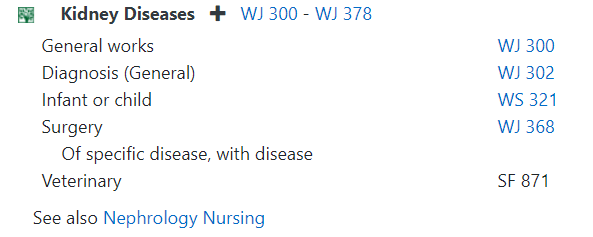Page 1 of 1
Finding the Appropriate Class Number
- After assigning the MeSH terms to a work, search the primary subject(s) in the index of the NLM Classification (Cf. Module 4—Descriptors: Selecting the Main Concept(s))
- Always check the main schedule for further instructions
- Read all annotations in the schedule (Note: Some general annotations appear at the beginning of the schedule)
- Take into account factors that may influence the classification (e.g., form, age group)
Specific Concepts
- In the NLM Classification index, some subjects may be indexed to a specific number. Note: these class numbers will also be visible in the MeSH browser, but the schedules should still be checked
Example:

- Always refer to the main schedule to verify the number to be certain there are no annotations directing the cataloger to use another number in specific circumstances
General Concepts
- Some subjects may include a range of numbers. Refer to the section of the class schedule to which the primary subject is indexed and select the most appropriate number.
Example:

- Refer to the section of the class schedule to which the primary subject is indexed and select the most appropriate number
- Select the class number annotated "General Works" if:
- the subject is very general
- the primary focus of the work includes several subjects within the schedule
Last Reviewed: April 16, 2021

